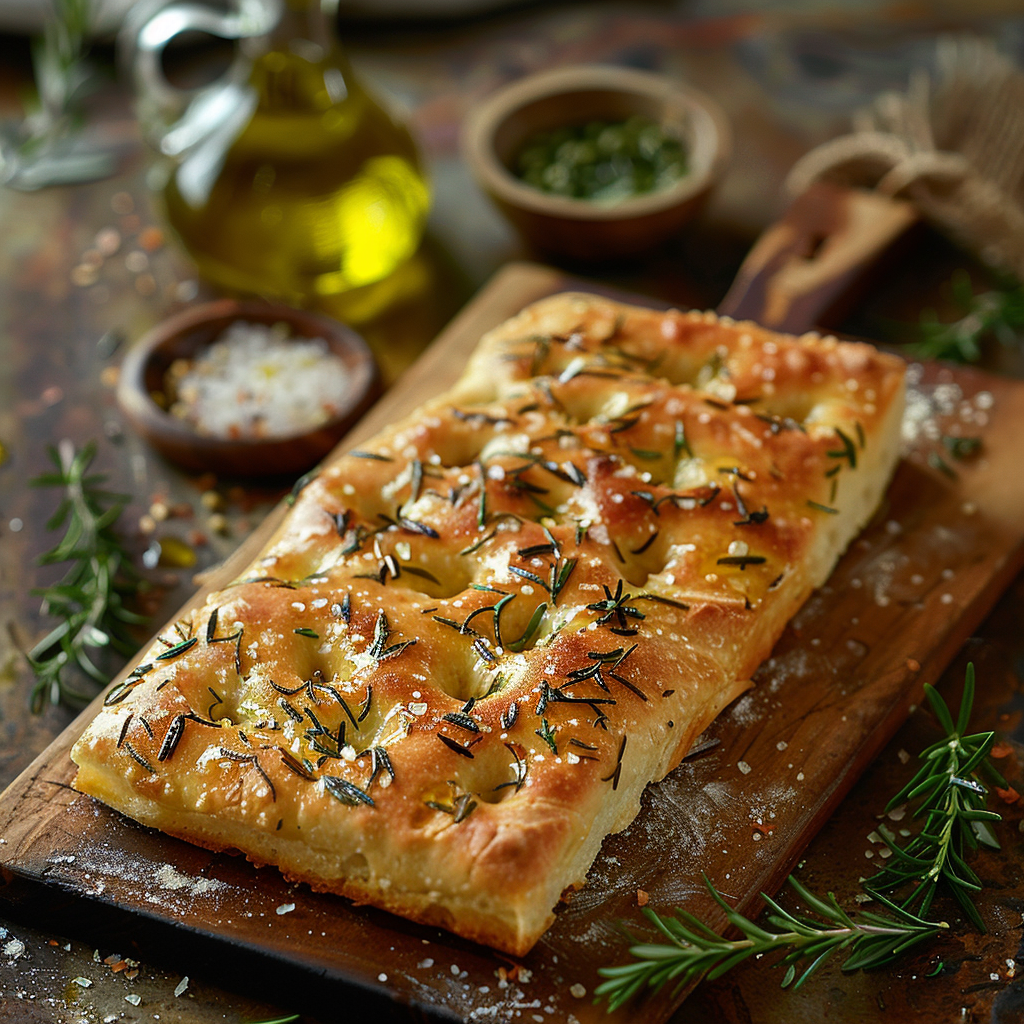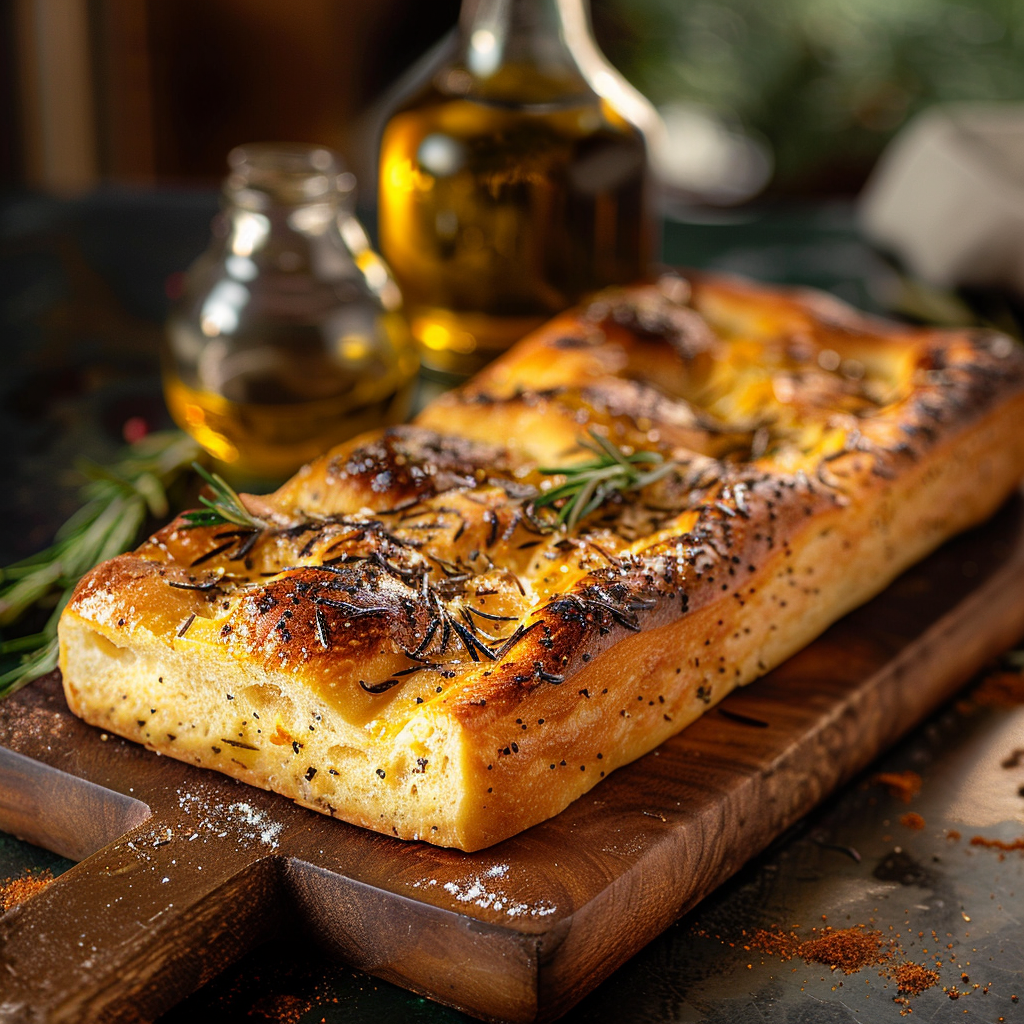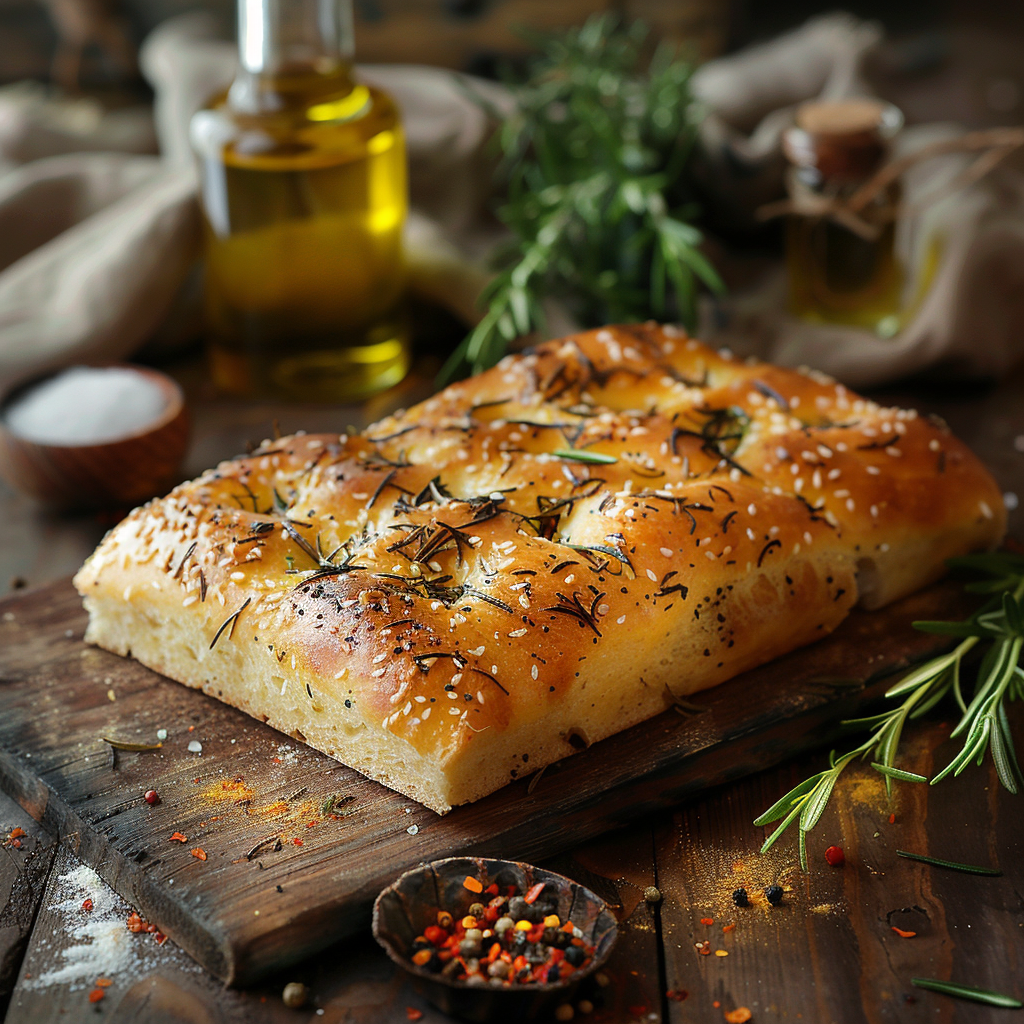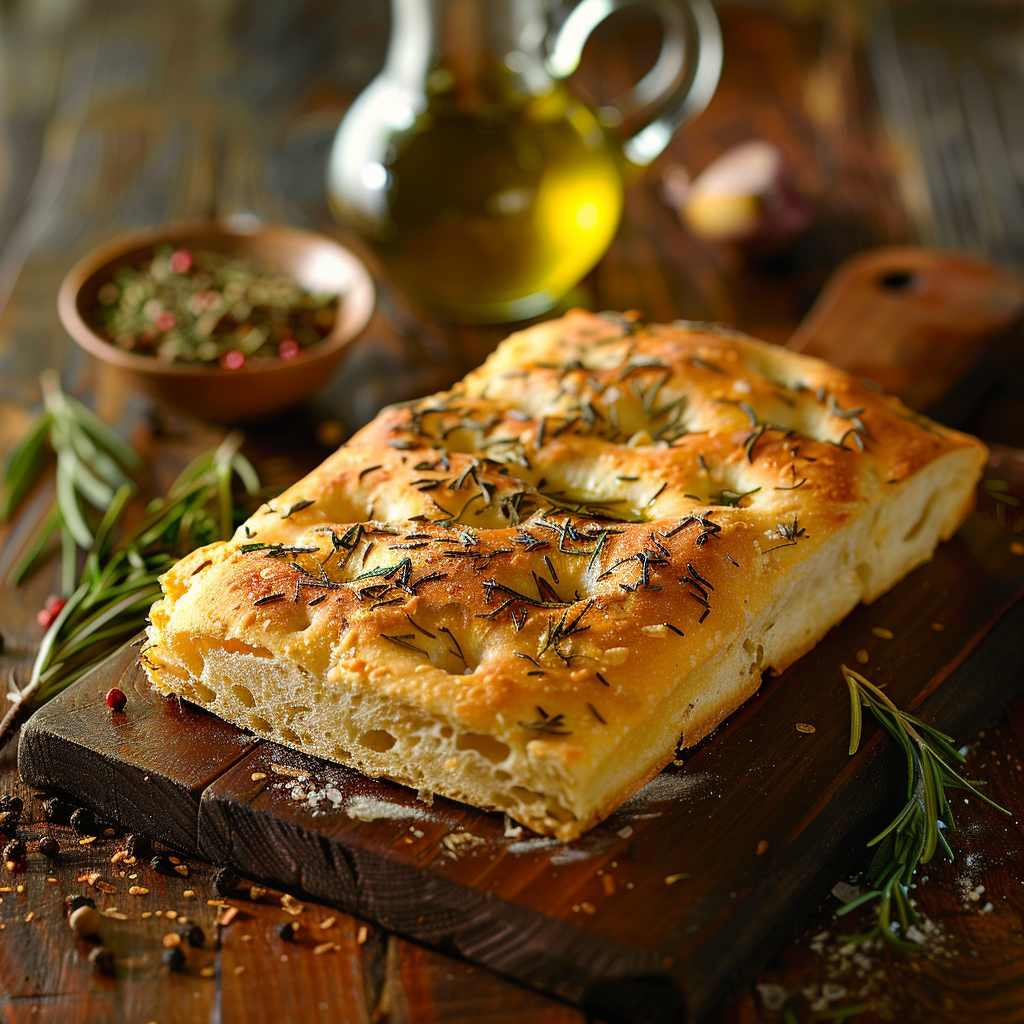
Why Rosemary Focaccia Bread Is a Must-Try
Picture this: It’s a lazy Sunday morning, and the smell of fresh bread wafts through your kitchen. That’s exactly what happened to me when I first tried making Rosemary Focaccia Bread. This Italian classic is like a warm hug in bread form—soft, chewy, and bursting with aromatic rosemary. Whether you’re a seasoned baker or just starting out, this recipe will make you feel like a pro. Plus, it’s so versatile! You can enjoy it as a side dish, sandwich bread, or even as a snack with olive oil for dipping.
A Little History Behind Rosemary Focaccia Bread
Focaccia has been around for centuries, originating in Italy’s Liguria region. The name comes from the Latin word “focus,” meaning hearth, because it was traditionally baked on hot stones. Over time, creative bakers added toppings like rosemary, garlic, and olives, giving birth to variations like garlic rosemary focaccia bread. My favorite story about focaccia? I once tried Jamie Oliver’s version (rosemary focaccia recipe Jamie Oliver) during a family gathering, and it was such a hit that everyone demanded the recipe!
Why You’ll Love This Recipe
This Rosemary Focaccia Bread is everything you want in homemade bread: crispy crust, fluffy interior, and fragrant herbs. It’s simple enough for beginners but impressive enough to wow guests. Plus, you can customize it with toppings like sea salt, cherry tomatoes, or caramelized onions. If you’ve ever wondered how to make focaccia bread fluffy, this recipe delivers without fail.
Perfect Occasions for Rosemary Focaccia Bread
Whether you’re hosting a dinner party, packing lunches, or craving a cozy snack, this bread fits the bill. Serve it alongside soups, salads, or pasta dishes for an authentic Italian vibe. It’s also perfect for holiday gatherings or weekend brunches. And if you’re looking for ideas on how to use focaccia bread, try making sandwiches with roasted veggies or grilled chicken—it’s a game-changer!
Ingredients
- 3 cups all-purpose flour (plus extra for dusting)
- 1 packet (2 ¼ teaspoons) active dry yeast
- 1 teaspoon sugar
- 1 cup warm water (about 110°F)
- 3 tablespoons olive oil (plus more for drizzling)
- 1 teaspoon salt
- 2 tablespoons fresh rosemary leaves (or 1 tablespoon dried rosemary)
- Coarse sea salt for sprinkling

Substitution Options
- Swap all-purpose flour with whole wheat flour for a nuttier flavor.
- Use dried rosemary if fresh isn’t available; just crush it slightly to release its oils.
- If you don’t have coarse sea salt, kosher salt works fine too.
Preparation Section
Step 1: Activate the Yeast
In a small bowl, combine the warm water, sugar, and yeast. Stir gently and let it sit for about 5–10 minutes until it becomes frothy. This step is crucial because it ensures your dough will rise properly. Pro tip: Make sure the water isn’t too hot, or it might kill the yeast. Think lukewarm bath—not scalding shower!
Step 2: Mix the Dough
In a large mixing bowl, whisk together the flour and salt. Add the activated yeast mixture and olive oil. Mix until a shaggy dough forms. Turn it onto a floured surface and knead for about 8–10 minutes until smooth and elastic. The dough should feel soft and slightly tacky but not sticky. If it sticks to your hands, add a bit more flour.
Step 3: Let It Rise
Place the dough in a lightly oiled bowl, cover it with a clean kitchen towel, and let it rest in a warm spot for about 1–2 hours. You’ll know it’s ready when it doubles in size. Imagine the dough taking a little nap while you relax—it’s a win-win!
Step 4: Shape and Top
Punch down the risen dough to release air bubbles. Transfer it to a greased baking sheet and stretch it into a rectangle or oval shape. Use your fingers to dimple the surface evenly. Drizzle generously with olive oil, then sprinkle on the rosemary and coarse sea salt. These dimples are what give Rosemary Focaccia Bread its signature look.
Step 5: Bake to Perfection
Preheat your oven to 425°F (220°C). Bake the focaccia for 20–25 minutes until golden brown. Your kitchen will smell incredible, trust me. Once done, transfer it to a wire rack to cool slightly before slicing. Chef’s tip: For extra crispiness, brush the top with a bit more olive oil right out of the oven.
Timing
- Prep Time: 20 minutes
- Cooking Time: 25 minutes
- Resting Time: 1–2 hours
- Total Time: About 2–2.5 hours
Chef’s Secret
To get that pillowy texture everyone loves, handle the dough gently during shaping. Overworking it can make the bread dense instead of light and airy. Also, don’t skimp on the olive oil—it’s key to achieving that irresistible crispness on top.
Extra Info
Did you know that focaccia is often considered the ancestor of pizza? Both share similar bases, but focaccia is thicker and richer thanks to all that olive oil. Fun fact: Some people call it “Italy’s answer to flatbread.”
Necessary Equipment
- Large mixing bowl
- Baking sheet
- Kitchen towel
- Rolling pin (optional)
- Oven
Storage
To keep your Rosemary Focaccia Bread fresh, store it in an airtight container at room temperature for up to 2 days. After that, it can go stale quickly, so consider freezing slices wrapped in plastic wrap and aluminum foil for longer storage.
If you plan to reheat it, pop it in the oven at 350°F (175°C) for 5–10 minutes to restore its crispiness. Avoid microwaving, as it can make the bread soggy.
For those who love meal prep, you can freeze unbaked dough. Simply shape it, let it rise halfway, then freeze. When ready to bake, thaw overnight in the fridge, finish rising, and bake as usual.
Tips and Advice
- Always use fresh yeast for best results. Old yeast won’t rise properly.
- Don’t rush the resting time—it’s essential for developing flavor and texture.
- Experiment with toppings like sun-dried tomatoes, olives, or grated Parmesan.

Presentation Tips
- Serve slices on a wooden board for a rustic touch.
- Garnish with additional fresh rosemary sprigs for visual appeal.
- Pair it with flavored oils or balsamic vinegar for dipping.
Healthier Alternative Recipes
Here are six variations to suit different dietary needs:
- Whole Wheat Focaccia: Replace half the all-purpose flour with whole wheat flour for added fiber.
- Gluten-Free Focaccia: Use a gluten-free flour blend designed for bread baking.
- Vegan Focaccia: Ensure all ingredients are plant-based—most recipes already are!
- Low-Sodium Focaccia: Reduce the salt and skip salty toppings like olives.
- Herb-Infused Focaccia: Add thyme, oregano, or basil along with rosemary.
- Stovetop Focaccia: Cook it in a skillet if you don’t have access to an oven.
Common Mistakes to Avoid
Mistake 1: Killing the Yeast
Using water that’s too hot kills the yeast, preventing the dough from rising. Always aim for lukewarm water. A good test is to dip your finger—if it feels comfortably warm, it’s perfect.
Mistake 2: Skipping Resting Time
Rushing the process leads to dense bread. Patience pays off here! Allow the dough to double in size for optimal texture.
Mistake 3: Overloading Toppings
While toppings are fun, adding too many can weigh down the dough. Stick to a few well-placed ingredients for balance.
FAQ
Can I make Rosemary Focaccia Bread in a bread machine?
Yes, you can! Use the dough setting to mix and knead the dough, then follow the shaping and baking steps manually. Just be sure to check your machine’s instructions for details.
Where can I buy focaccia bread?
Many grocery stores sell pre-made focaccia in their bakery section. Specialty markets or artisan bakeries may offer higher-quality options.
How do I know when the focaccia is fully baked?
The bread should be golden brown on top and sound hollow when tapped on the bottom. An internal thermometer should read around 190°F (88°C).
What are some popular focaccia bread toppings?
Classic toppings include rosemary, garlic, sea salt, cherry tomatoes, olives, and caramelized onions. Get creative based on your taste preferences!
Can I freeze focaccia bread?
Absolutely! Wrap slices tightly in plastic wrap and foil before freezing. Reheat in the oven for best results.
How do I make my focaccia bread fluffy?
Ensure proper yeast activation, gentle handling of the dough, and sufficient resting time. Adding a bit more olive oil helps too!
Is focaccia bread healthy?
It depends on portion sizes and ingredients. Whole grain versions are healthier, while traditional recipes are indulgent yet delicious.
Can I use dried rosemary instead of fresh?
Yes, use 1 tablespoon of dried rosemary for every 2 tablespoons of fresh. Crush it slightly to release its aroma.
What pairs well with focaccia bread?
Focaccia goes great with soups, salads, dips, and charcuterie boards. It’s also fantastic as sandwich bread.
Do I need special tools to make focaccia?
No fancy gadgets required! Basic kitchen tools like bowls, a baking sheet, and a rolling pin (optional) are all you need.
Final Thoughts
Making Rosemary Focaccia Bread is a rewarding experience that fills your home with warmth and wonderful aromas. Whether you stick to the classic recipe or experiment with new toppings, this bread is sure to become a staple in your kitchen. So grab your apron, gather your ingredients, and let’s bake something magical together!


Rosemary Focaccia Bread
Ingredients
Equipment
Method
- In a small bowl, combine the warm water, sugar, and yeast. Stir gently and let it sit for about 5–10 minutes until frothy.
- In a large mixing bowl, whisk together the flour and salt. Add the activated yeast mixture and olive oil. Mix until a shaggy dough forms.
- Turn the dough onto a floured surface and knead for about 8–10 minutes until smooth and elastic.
- Place the dough in a lightly oiled bowl, cover with a kitchen towel, and let it rest in a warm spot for about 1–2 hours until it doubles in size.
- Punch down the risen dough to release air bubbles. Transfer it to a greased baking sheet and stretch it into shape.
- Use your fingers to dimple the surface, drizzle with olive oil, then sprinkle on the rosemary and coarse sea salt.
- Preheat your oven to 425°F (220°C). Bake for 20–25 minutes until golden brown. Transfer to a wire rack to cool slightly before slicing.
